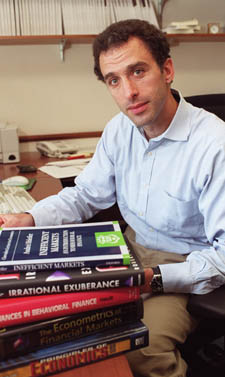Predicting the unpredictableJeremy Stein analyzes the vagaries of behavioral finance

Precariously perched on a tiny scaffold 170 feet in the air over the Nevada desert last summer, Jeremy Stein anxiously contemplated an awe-inspiring feat – a bungee jump into a 13-foot-deep swimming pool in Las Vegas. Stepping off the ledge, Stein began his free fall, only slightly splashing the water as the cord whipped him back high in the air. “It was cool,” he says.
This fall, the recently appointed professor of economics in the Department of Economics at Harvard University is diving headfirst into his newest challenge – teaching finance in both the undergraduate and Ph.D. programs.
“It’s sort of a change for me,” says Stein, who spent the past 10 years as a professor of finance at the Sloan School of Management at the Massachusetts Institute of Technology. “What I did [at M.I.T.] was high-volume MBA teaching in the sense that I had three sections with almost a hundred students each – I was really cranking it out. … It’s pretty different here.”
Stein is enthusiastic about the prospect of working with smaller groups of students concentrating in finance, a subject he’d been fascinated with even before spending a year as a staff member with the Council of Economic Advisers in Washington, D.C.
“It was a great experience,” Stein relates. “I went down there right after the savings and loan crisis amid all the talk of banking reform … so the hook for me was to write some banking legislation.” Stein actually spent most of his time attending many low-level staff meetings and writing detailed appendices to reports, but he says it was “a nice way to spend a year.”
After attending Princeton University as an undergraduate, then earning his Ph.D. in economics from M.I.T., Stein spent a year on Wall Street working as an intern for Goldman Sachs and Co. “I wasn’t sure if I was going to stick around academics,” he says, “so I was sampling different things.”
Eventually Stein embarked on an academic path for his career. “It was never an explicit choice at any point,” he says. “I just started to enjoy it, and got hooked on the lifestyle. And after working at this job for a while, working on Wall Street seems harder to imagine.”
Although Stein has divorced himself from the daily rigors of Wall Street, stock market efficiency – or “behavioral finance” as he calls it – remains the crux of Stein’s research. “I know very little about psychology research, but I am very interested in market interactions,” he says. “The label of ‘behavioral finance’ has really attached itself to anything in finance tied into the stock market that’s not really the strictly orthodox way of looking at it.”
Stein collects and analyzes empirical data to formulate and test theories on market activity and investor behavior. He admits his research often violates some venerable economic principles.
“For many years there was this very orthodox efficient market thing,” Stein explains. “The theory was … you can’t make money in the market because it’s unpredictable – which was consistent with this world view.
“Then, over the past 10 to 15 years, there’s been this huge amount of evidence coming in that’s starting to suggest that the market is predictable one way or another,” he says. “People were finding that if a stock has been going up over the last six months … it is likely to continue to go up over the next six. The winners stay winners and the losers continue to lose. … At the same time, other people were finding that when they looked over longer horizons, you get reversals.”
Those momentum reversals and effects – what causes them and why – comprise the cornerstone of Stein’s latest research in conjunction with Stanford University Professor Harrison Hong. They are examining how the dissemination of information among investors affects the market, with their theory being that the longer it takes for information to spread, the longer a particular stock will continue moving in one direction or another.
Stein is also working with Anil Kashyap, professor of economics at the University of Chicago, on monetary policy. “When [Alan] Greenspan decides that he wants to choke the economy, what exactly goes on? What is it he can do that somehow at the end of the day results in interest rates going up and banks lending less?” Stein wonders. “We’ve been particularly interested in the role that commercial banks play in this process.”
Stein, who lives in Lexington with his wife and three children, hopes to bring his expertise on monetary and market issues to life in the classroom at Harvard. This coming spring semester he will be teaching two Ph.D. finance courses. Next year, he’ll begin instructing undergraduates.
“Stylistically, I think the course I’m going to teach will be an advertisement for a certain style of work,” Stein explains. “I tend to be super low-tech. I do a little bit of theory and a little bit of empirical work. … It’s really interesting and really satisfying to have simple theory and be able to take it to data. Some types of theories don’t lend themselves so easily to testing, but with finance, and particularly the stock market, data is staring at you in the face.”
It’s more than enough to fuel Stein’s ongoing research projects and his classroom instruction. And it may be enough to keep him from strapping on the bungee cord again – for a while, anyway.




